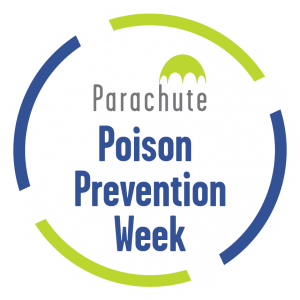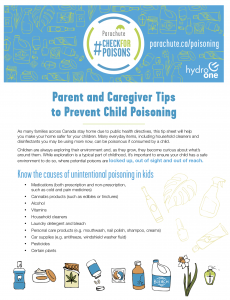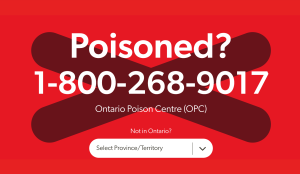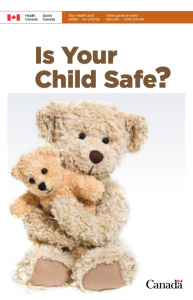
National Poison Prevention Week is an annual campaign to raise public awareness of poisoning injuries in Canada, encouraging community involvement as part of the solution.
For 2026, the campaign will encourage people in Canada to #RethinkPoisons. The campaign will focus on the importance of using over-the-counter medications and natural health products safely. These products are easy to find in stores, online and at home and they are safe for most people if used in the right ways. However, there are dangers if they are not used correctly.
The goal of the campaign will be to empower people in Canada to talk to their doctor or pharmacist about medications and natural health products, read labels carefully and use products safely.
Possible poisoning? Call your local poison centre.
Canada has a toll-free 24/7 number for poison centres. If you suspect a poisoning, call 1-844-POISON-X (1-844-764-7669).
If you are located in Nunavut, contact your local health centre. If you are located in Québec, call 1-800-463-5060.
Keep the number of your poison centre nearby or in your phone. Program the number into your phone’s contact list or keep it in a visible location, such as on your fridge.
If the person loses consciousness, has difficulty breathing or is having a seizure, call 911.
There are many resources available if you or someone you know is in crisis and in need of support. Call your local poison centre if you suspect self-harm by poisoning.
If you or someone you know:
- Requires urgent medical care, call 9-1-1.
- Is thinking about suicide, call or text 9-8-8. In Québec, call 1-866-APPELLE. Support is available 24 hours a day, seven days a week.
- Is looking for substance use support, find Canada-wide and regional support services.
Resources
2026 Poison Prevention Week resources
-
Social media images — Poison Prevention Week 2026
2025 Poison Prevention Week resources
-
Backgrounder – Poison Prevention Week 2025
2024 Poison Prevention Week resources
-
Backgrounder — Poison Prevention Week 2024
-
Social media images — Poison Prevention Week 2024
-
Pediatric cannabis poisoning social media images (CCSA)
Additional resources
These downloadable resources can be used to educate and inform on the topic of safe storage of cannabis and other poisons.
-
Poison storage checklist for your house
Keep your children safe by keeping these household poisons locked up, out of sight and out of reach.
1.17 MB PDF/UA
-
Poison storage checklist for your apartment
-
Parent and Caregiver Tips to Prevent Child Poisoning
Videos: Help is a call away
These videos share stories about poison centre calls and were created in 2023 with funds from Health Canada and in partnership with the Canadian Association of Poison Centres and Clinical Toxicologists (CAPCCT) and Parachute.
-
Stephanie’s advice: keep the poison centre phone number nearby
Stephanie, a mom of three from P.E.I. talks about why she always keeps the poison centre phone number nearby in the event of a poisoning emergency. Learn how poison centres can help and find the phone number for your poison centre at infopoison.ca.
-
Panicked when your child eats a mystery plant? Call the poison centre.
Stephanie, a mom of three, talks about her experience calling the poison centre after her daughter ate an unknown plant from the garden. Learn how poison centres can help and find the phone number for your poison centre at infopoison.ca.
-
“Having the poison centre to call is such a reassurance”: Stephanie, a mother of three children.
Stephanie, a mom of three, talks about her experience calling the poison centre. Learn how poison centres can help and find the phone number for your poison centre at infopoison.ca.
-
“The advice I’ve gotten has always been fantastic”: Brittany’s experience with a poison centre call
Brittany, a mom of two from Saskatoon, shares her experience calling a poison centre after her daughter unintentionally receives a double dose of medication. Learn how poison centres can help and find the phone number for your poison centre at infopoison.ca.
-
“The advice I’ve gotten has always been fantastic”: Brittany’s experience with a poison centre call
Brittany, a mom of two from Saskatoon, shares her experience calling a poison centre after her daughter unintentionally receives a double dose of medication. Learn how poison centres can help and find the phone number for your poison centre at infopoison.ca.
-
When medication can harm: How a poison centre helped a caller in distress
Crissy Amiana, a Certified Specialist in Poison Information at the Ontario Poison Centre, shares her story of responding to a case of an older adult who unintentionally took the wrong medication. Learn how poison centres can help and find the phone number for your poison centre at infopoison.ca.
-
Medication is a common cause of poisoning: How the poison centre can help
Crissy Amiana, a Certified Specialist in Poison Information at the Ontario Poison Centre, shares her story of responding to a case of an older adult who reached out when she unintentionally took the wrong medication, but it turns out the real issue was the combination of medications she was taking for herself. Learn how poison centres can help and find the phone number for your poison centre at infopoison.ca.
-
When cannabis gummies fall into little hands: Calling the poison centre for help
Amin Rajwani, a Certified Specialist in Poison Information at the Poison and Drug Information Service in Alberta, shares a case where a child was hospitalized after eating their grandfather’s cannabis edibles. Learn how poison centres can help and find the phone number for your poison centre at infopoison.ca.
Poison prevention resources from our partners across Canada
-
Opioid Poisoning Educational Posters
From the Canadian Red Cross, posters are available on the signs of opioid poisoning and how to care for someone experiencing opioid poisoning
-
Bud Talks: Cannabis and Older Adults
This resource for older adults outlines the risks associated with cannabis use, cannabis drug interactions as well as considerations around certain medical conditions and cannabis use.
-
Canadian Association for Poison Centres and Clinical Toxicology
-
Health Canada: Is Your Child Safe?
-
BC Injury Prevention Unit: quick facts about poisoning
The BCIRPU’s Poisoning webpage provides provincial statistics for British Columbia, prevention tips and resources.
-
Child Safety Link Safety at Home: Poison Prevention
Child Safety Link is based out of the IWK Regional Poison Centre and its goal is to help educate Maritime communities about poisoning prevention This Poison Prevention webpage includes resources and videos.
-
Ontario Poison Centre
Serving Ontario, Manitoba, and Nunavut, this website has information for families and health professionals, including common causes of poisoning in Ontario.
-
Poison and Drug Information Service (PADIS), Alberta
From Alberta Health Services, the webpage has information about PADIS services and answers to frequently asked questions. PADIS serves Alberta, Saskatchewan and the Northwest Territories.
-
“Poison Prevention…It’s in Your Hands”, Saskatchewan Prevention Institute
-
Preventing poisoning in Alberta children (Injury Prevention Centre)
-
Québec Poison Control Centre
The Québec Poison Control Centre website has information and resources on poison prevention; basic information is provided in English and French, with extensive resources for professionals in French.
-
Saskatchewan Prevention Institute: Poisoning
The SPI Poisoning webpage has provincial data on child poisonings and downloadable fact sheets, posters and activities.
-
Injury Prevention Centre: Canadian Drug Facts table for non-prescription medication from IPC
This resource from the Injury Prevention Centre explains the Canadian Drug Facts Table, found on non-prescription medications in Canada.
-
Injury Prevention Centre: Giving medication safely
This resource from the Injury Prevention Centre provides guidance for parents and caregivers on how to safely administer medication to children.
-
Health Products Stewardship Association: Returning medications
Find a collection location near you where you can drop off expired and unwanted medications and used medical sharps.
Programs
Injury Topics
Professional Resources
Media
-
Link
National Poison Prevention Week: Ways to prevent inadvertent poisonings
Global News Toronto — March 20, 2024
-
Link
Message from the Minister of Health for Poison Prevention Week 2024
www.canada.ca — March 18, 2024
-
Link
Poison Prevention Week March 20 – 26, 2022 Town of Ajax
www.ajax.ca — March 21, 2022
-
Link
Pandemic posing increased poison risks for children
www.rcinet.ca — March 22, 2021
-
News release
National Poison Prevention Week campaign calls on Canadian residents to #Check
For Poisons among ordinary household items March 19, 2021
-
News release
National Poison Prevention Week campaign focuses on children and cannabis
March 12, 2020
-
Link
Spike in cannabis poisoning in kids a concern for doctors: ‘It’s candy and it tastes great’
Global News — October 11, 2018
-
Link
Marijuana Can Be Poisonous For Young Kids, So Here’s How To Store It Safely
HuffPost Canada — October 12, 2018
-
Link
VP, Pamela Fuselli, about the dangers of children being exposed to cannabis
CTV News — October 15, 2018
-
Link
President Steve Podborski about dangers of cannabis
Winnipeg Sun — October 14, 2018
-
News release
As cannabis becomes a legal drug in Canada, remember it can be poisonous to children
October 10, 2018
-
Link
With cannabis legalization looming, doctors foresee uptick in emergency-room visits
Globe and Mail — October 14, 2018




